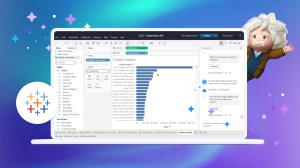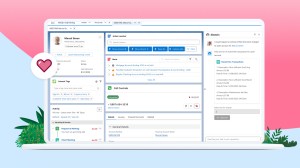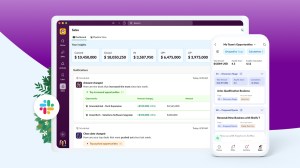Salesforce Exec on 5 Considerations for Disaster Relief Technology Amid Digital Transformation




Nasi Jazayeri
Disease outbreaks, wildfires, earthquakes, wars — there is no shortage of crises requiring urgent response in today’s world. And with the dual challenges of climate change and a changing geopolitical landscape, the frequency and intensity of disasters will only increase.
To meet the unprecedented growth in demand for emergency response, companies, governments, and nonprofits should look to the very same strategy employed during the height of the COVID-19 pandemic — digital transformation.
Five criteria for disaster relief technology
When undergoing digital transformation, every agency and company must be aware of the important choice in front of them — finding the right tools and partners that empower their organizations rather than complicate them.
To provide critical support and make an impact, public, private, and non-profit entities need technology that includes these five factors:
1. Centralized data
Emergency responders can serve constituents more effectively when their tools capture high-quality and real-time data and can be customized for various users and needs.
After Russia invaded Ukraine in February 2022, a wave of refugees fled to neighboring Moldova. Children’s Emergency Relief International (CERI), a humanitarian aid organization, stepped in to offer social services and support. Working with Coastal Cloud, a Salesforce partner, CERI built a data-focused emergency case management system on the Salesforce platform within weeks, customized to users speaking multiple languages, to ensure they were prepared to serve people in the region.
By collecting high-quality data in one place, CERI could track cases and outcomes across Ukraine, address bottlenecks, and strengthen logistics. “Information is now centralized and visible in real time to supervisors, and program management decisions can be made fast in a data-driven way,” said Connie Belciug, CERI’s executive director.
Information is now centralized and visible in real time to supervisors, and program management decisions can be made fast in a data-driven way.
Connie Belciug, CERI
2. Agility
In an emergency, conditions change quickly and there isn’t much time to plan. Meanwhile, rapid response can mean the difference between life and death. Organizations tackling crises need tools that enable them to change course immediately.
When the pandemic hit, CDR Maguire, a contractor specializing in emergency management, was tasked with helping the Florida Division of Emergency Management set up COVID-19 testing services across the state. Partnering with Coastal Cloud, CDR Maguire created a customized resource planning platform on Salesforce that facilitated more than 4 million COVID-19 tests and another 4 million vaccinations.
“Requirements were changing literally overnight. We were able to respond thanks to the power of the Salesforce platform and our ability to configure and deploy it very quickly,” said Tim Hale, co-founder and managing partner of Coastal Cloud.
We were able to respond thanks to the power of the Salesforce platform and our ability to configure and deploy it very quickly.
Tim Hale, Coastal Cloud
The emergence of generative AI technology gives organizations access to even more powerful tools in the event of an emergency, including better disaster resource management by analyzing population density and logistics, mass citizen outreach for evacuation routes or locations of medical supplies through personalized routing, or even to train first responders with simulated emergency scenarios.
Afterwards, organizations can use generative AI to make sure infrastructure maintenance is optimized by analyzing equipment performance and usage patterns, which can help utility companies better manage downtimes and prevent outages.
3. Accessibility
In a crisis, most responders can’t stay in an office or behind a computer screen. They need mobile tools available to anyone in the field, whether in transit, at a disaster site, or in a shelter. When speedy action and collaboration are vital, emergency responders across multiple agencies need access to relevant information at lightning speed via common data dashboards.
“On game day, when bad things happen, emergency managers need to have a common operating picture,” said Lisa Amaya, executive director for National Emergency Management and Response. “Knowing where your resources are, where your people are, and your highest priority issues, and being on the same page is absolutely critical.”
4. Scalability
In a disaster, it’s hard to predict how many people will need help and when, but meeting the needs of a large number of people quickly is critical. Technology for emergency response management needs to scale along with demand, offering aid nearly instantaneously to as many people as possible.
The American Red Cross, a nationwide network of nearly 270 chapters and 36 blood service regions, uses Salesforce to deliver vital services during disasters and emergencies.
Salesforce helps the organization consolidate information from 150 national partners and more than 250 local field units. It also helps the Red Cross manage relationships with volunteers, donors, and service recipients more effectively, and support fundraising, case management for emergency assistance, blood drive campaigns, and the transportation and sale of blood and blood products to hospitals and healthcare providers. And, Salesforce helps the Red Cross rally volunteers and get the word out faster on social media.
“Salesforce helps us stay connected to our most valuable resources — the volunteers, partners, and donors that make what we do possible,” says Ronnie Strickland, CIO of American Red Cross.
5. Transparency
Tools supporting disaster relief need to be easily audited, providing a clear way to track resources and funds, report for grants and reimbursement, and prevent fraud.
When COVID-19 hit, the California Governor’s Office of Emergency Services needed to urgently distribute personal protective equipment (PPE) but had no way to manage potential donors and suppliers. Working with Four Leaf as an implementation partner, officials set up a one-stop-shop system for ordering, distributing, and tracking PPE across the state within 72 hours.
The office used the platform to source $2 billion in PPE over 45 days, including validating thousands of donors and vendors. “This application allows the procurement team to have a clear line of sight throughout the procurement process,” said Eric Scully, the founder and CEO of Four Leaf.
Working with Four Leaf as an implementation partner, officials set up a one-stop-shop system for ordering, distributing, and tracking PPE across the state within 72 hours.
When technology is a lifesaver
Much of emergency response management, particularly in the public sector, still relies on outdated technology. Given the growing scale and frequency of disasters, organizations of all stripes are realizing they need robust digital tools to deliver aid effectively. When sourcing technology, organizations should look for platforms that give multiple stakeholders access to high-quality data from anywhere, serve constituents at scale, and can adapt quickly to changing conditions.
What’s at stake is nothing short of people’s lives and well-being.
Dive deeper
- Learn more about Customer 360 for Public Sector and the latest in public sector innovations here
- Review findings from Salesforce’s New Era of Data Stewardship in Government survey
- View the Salesforce Connected Government Report here















